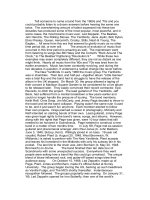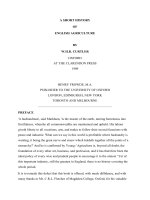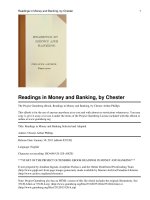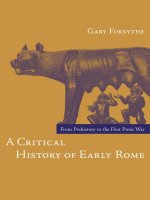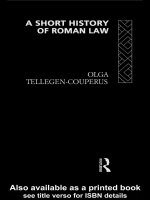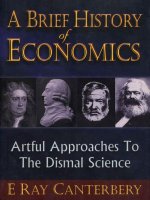A short history of paper money and banking
Bạn đang xem bản rút gọn của tài liệu. Xem và tải ngay bản đầy đủ của tài liệu tại đây (24.17 MB, 422 trang )
A SHORT HISTORY OF
PAPER MONEY & BANKING
Also Published In
Reprints of Economic Classics
By WILLIAM M. GOUGE
THE FISCAL HISTORY OF TEXAS [1852]
A
SHORT HISTORY
OF
PAPER MONEY AND BANKING
IN THE UNITED STATES
TO WHICH IS PREFIXED
AN INQUIRY
INTO THE
PRINCIPLES OF THE SYSTEM
BY
WILLIAM II. GOUGE
[1833]
With An Introductory Essay
"William M. Gouge and the Formation of
Orthodox American Monetary Policy"
By JOSEPH DORFMAN
Reprints of Economic Classics
AUGUSTUS M. KELLEY PUBLISHERS
New York 1968
First Edition 1888
(Philadelphia: Printed by T. W. Ustick; and for Sale
by Grigg & Elliott, No.8 N. Fourth St., Uriah Hunt,
No. 19 N. Third St., Hogan & Thompson, No. 139%
Ma1·ket St., 1888 )
Reprinted 1968 by
AUGUSTUS M. KELLEY· PUBLISHERS
New York New York 10010
Library of Congress Catalogue Card Number
65-26866
ABJ::
Gift
Publiah~I
Copy
PRINTED IN THE UNITED STATES OF AMERICA
~Y SENTRY PRESS, NEW YORK, N. Y. 10019
William M. Gouge and the Formation
of Orthodox American Monetary Policy
Few areas in American history have undergone
such intensive study in recent years as the Jacksonian era. A major subject of controversy in that
period is monetary and banking policy. It began
with President Jackson's successful veto of the bill
for rechartering the embryonic central bank, the
Second Bank of the United States, in 1832. The
subsequent struggle on both the federal and state
levels rocked the nation intermittently for a decade.
The ablest writer on the orthodox Jacksoni~n hardmoney side was William M. Gouge (1796-1863); the
bible of the movement was his' A Short History of
Paper Money and Banking in the United States, ...
to which is Prefixed an Inquiry into the Principles
of the System (1833).1
It seems to have been the first American economics
treatise to win an international reputation. An
abridged version was published in the influential
Brussels journal, La ReV'ite Universelle ; in England
the second part, the history part, was brought out
by the leading political journalist, the radical William Cobbett. The foremost popularizer of the
dominant British classical school, J. R. McCulloch,
commended the treatise for its detailed history of
American banking. The praise which it received at
home as well as abroad was in good part due to
1
The edition which is reprinted below is the first edition.
Subsequent editions contained only minor changes. The last
appeared in 1841-1842 as supplements to his bi-weekly The
Jt:YUrnal of Banking.
5
6
WILLIAM M. GOUGE AND THE FORMATION
Gouge's careful research. For this he spent over two
years at the library of the American Philosophical
Society, Philadelphia, a rough counterpart of the
famed British Museum. Gouge supplemented this
by correspondence with knowledgeable persons in
various states. Such was the level of the work that
it is still a primary source for information on the
history and organization of American banking,
especially for the first third of the nineteenth
century, a period when the veil of secrecy surrounding banking was even tighter than in other fields.
Gouge was an agile writer, shy in personal contact and adverse to speech making, but possessed of
a persuasive pen, steeped at times in wit and satire.
He "was one of the most thorough students of our
early banking [including the security and money
markets] and also one of its keenest and most
influential critics. ' '2
To furnish perspective on his monetary and banking views, it seems desirable to provide a short biographical sketch and a statement of his general
economic philosophy. The son of an apothecary, he
was born and raised in Philadelphia. Though he
was to spend most of his mature life in Washington,
he always preferred large cities, especially New
York. 3
2 Harry E. Miller, Banking Theories in the United States
Before 1860 (Cambridge, Mass.: Harvard University Press,
1927) p. 86.
3 While inspector of customs in New York in 1843, Gouge
was reluctant to be transferred to Washington on the ground
that New York" affords a greater variety of objects with
which to divert the mind." (Gouge to J. C. Spencer, October
25, 1843, National Archives, Treasury.)
OF ORTHODOX AMERICAN MONETARY POLICY
7
His career consisted largely of his activities as
a financial journalist and as an employee of the
-United States Treasury; he pursued these occupations simultaneously for a good part of his life. He
began as a journalist and first achieved prominence
in Philadelphia while serving as co-publisher and
editor (with Stephenson Smith) of the Philadelphia
Gazette and City Advertiser from 1823 to 1831. He
devoted the newspaper chiefly to monetary and
banking reforms, advocating primarily what became a part of the Jacksonian creed, the prohibition
of small bank notes, as a first step in the elimination
of all bank notes. At the same time he helped prepare a so-called "workingmen's" memorial to the
Pennsylvania legislature which sought to prohibit
the chartering or rechartering of banks with the
corporate power of limited liability.4 But this was
one of those periods when there was relatively little
public interest in currency and banking questions.
Gouge's newspaper constantly lost subscribers and
he was forced to give up what" had promised to be
one of the most lucrative newspaper establishments
in the country. " 5
Ten years later, he again attempted the role of
4 For a discussion of this memorial, see Joseph Dorfman,
"The Jacksonian Wage Earner Thesis," 1949, reprinted in
The Economic Mind in American Civilization (1946; reprinted by Augustus l\L Kelley • Publishers, 1966) II,
appendix.
5 Gouge to F. P. Blair, August 17, 1831, Blair Papers,
Princeton University Library. He explained that the Gazette
had not attacked that "terrific institution," the Second
Bank of the United States, because he would soon have been
without adequate funds just to print the paper.
8
WILLIAM M. GOUGE AND THE FORMATION
editor and publisher; he started the bi-weekly The
Journal of Banking, but the result was the same.
After a year he was forced by the loss of subscriptions to suspend publication, complaining of the
public's antipathy to economic abstractions, especially "the science of currency." He pointed to the
fate of TheJournal of Banking as further evidence
that" no journal of political economy or statistics,
in either Europe or America . . . has ever repaid
expenses. ' , 6
Gouge's journalist activities were not limited to
his own ventures; from the 1830 's down to the
Civil War he was a valued contributor to and
adviser of such influential financial and economic
journals as Hunt's Merchants' Magazine and The
Bankers' Magazine and Statistical Register, and
such leading Democrat~c party organs as the Washington Globe and The United States Magazine and
Democratic Review.
From about 1834 to March 1862, Gouge was with
the Department of the Treasury except for relatively short periods when the Democrats did not
occupy the presidency. Even when the Whigs and
their successors were in power, he managed to retain
his post for a part of the time. 7 He began, as he
put it, as a "mere accountant and copyist, " but was
Notice, " The J oornal of Banking, June 22, 1842, p. 404.
Gouge was dismissed in April 1841 when the Whigs came
to power, but he came back in 1843. In April 1851, after the
Whigs had won the presidency, Gouge was again forced out
and finally on March 3, 1862, after the Republicans had been
in office for a year, he was dismissed. At the time his salary
was $1,600 a year.
6 , ,
7
OF ORTHODOX AMERICAN MONETARY POLICY
9
soon charged with the duties of what may be called
"the statistical and politico-economical clerk" of
the bureau that served as the immediate staff of
the Secretary of the Treasury.8 In this capacity
he should be credited with services of value not only
to government but also to the growth of economic
science and especially monetary and banking policy.
As he described it, his was the task of collecting
and arranging the materials that went into the
detailed statement of the condition of the banks
throughout the Union which the Secretary of the
Treasury laid before Congress each year. 9 He
used his skills as accountant and statistician to
improve the collection and systematization of monetary and banking data that Treasury, Congress and
the business world used in making decisions. 10
Perhaps more important for our purposes was
his involvement in policy making. He served as an
economic adviser to secretaries of the treasury in
Democratic administrations and such outstanding
Jacksonian leaders in the monetary controversies
as Senator Thomas IIart Benton of Missouri and
Benjamin F. Butler, Attorney General in Jackson's
second administration. Occasionally Gouge worked
directly with President l\iartin Van Buren.
8 Gouge to President Van Buren, July 17, 1840, Van Buren
Papers, Library of Congress; Gouge to J"ames G. Guthrie,
March 10, 1853, National Archives, Treasury.
9 Even when out of government service, he continued to
collect data in part with the help of correspondents such
as his fellow collector of statistics and future Democratic
party candidate for the presidency, Samuel J. Tilden.
10 This function is now largely performed by the Comptroller of the Currency.
10
WILLIAM M. GOUGE AND THE FORMATION
His general economic philosophy was in the
J efferson-Jackson laissez faire tradition. This view
he showed more formally in his adherence to Adam
Smith and "the axioms of political economy" of
the British classical school typified by David
Ricardo and its continental counterpart led by
Jean-Baptiste Say.ll Gouge, like the classical
economists, held that the theory of value was basic
in any economic discussion. The laws of supply and
demand were all-powerful in the determination of
value. For natural value, cost of production was the
determining condition of supply, and back of
demand was the adaptation of the goods to the wants
and desires of the people. "The market value . . .
is in the compound ratio of their utility and of
their scarcity. "1'2 Thus the prices of goods and all
factors of production would be "much better regulated by free competition than ... by governmental
enactments. ' , 13
11 His favorite was always Adam Smith. He complained
that The Wealth of Nations was seldom reprinted in the
United States whereas English translations of Say's treatise
were reprinted many times; "but this is chiefly owing to its
having been adopted as a textbook in the colleges, and to a
study of it being requisite to enable young men to take their
degrees." (" Political Economy," The Journal of Ban:king,
February 2, 1842, p. 242).
12 Below, Part I, pp. 10, 11.
Gouge commented on what came to be called marginal
utility analysis: "Value is, according to some approved
writers, in its ultimate analysis, 'a judgement of the mind.'
It would carry us too far into the regions of metaphysics to
show how they make this out." (" The Standard of Value,"
The Jour'TWJ1, of Banking, March 16, 1842, p. 290).
13" Remarks, "
The JO'Il/Nwl of Banking, December 22,
1841, p. 196.
0]' ORTHODOX AMERICAN MONETARY POLICY
11
Business corporations, especially banks, possessed
of the privilege of limited liability and other
perquisites, were "incompatible with the equality
of rights and unfavorable to the progress of national
wealth. " In the absence of "the Argus eyes of
private interest ... their affairs are much more carelessly and ... expensively conducted than those of
individuals." 14
He questioned the desirability of laws fixing a
maximum rate of interest; here he differed fronl
his master, Adam Smith, and followed instead
Jeremy Bentham's Defence of Usury (1787).15
"Loanable capital in the form of money, varies in
value ... [Consequently] it is as absurd to attempt
to fix the rent or interest of money ... as it would
be to :fix the rent of houses or lands that are bought
,vith money." Furthermore, if banks were free to
raise the interest on loanable capital, as its value
in the market increased, this action ,vould "put the
whole community on their guard, and many a fever
of wild speculation would be checked" at the very
start. 16 Similarly governments might issue bonds at
a heavy discount but they must redeem them at
their nominal price lest the affected states lose their
credit.
Below, Part I, p. 41.
Gouge commented humorously that the tract" was free
from those peculiarities of phraseology which render other
of Bentham '8 works sealed books to the great mass of
readers." ("Bentham 011 Usury," The Journal of Banking,
April 18, 1841, p. 52).
16 "Banking as It Ought to Be," The United States
Magazine and Democratic Review, April 1843, p. 427.
14
15
12
WILLIAM M. GOUGE AND THE FORMATION
The claims of the honest capitalist, Gouge insisted,
were just as sacred as those of the honest laborer.
His theory of wages was the traditional wages-fund
doctrine: "Every increase of capital increasing the
fund out of which wages would be paid, would
increase the reward of the laborer. " Gouge chastised
the lazy and improvident for neglecting to accumulate a capital and thus making themselves
independent of "others for means of both subsistence and employment." 17
On the other hand, on matters such as the safety
of steamboat passengers, he was a strong supporter
of the policy of regulation which President Jackson
had promoted. Thus in reporting in 1854 to the
Secretary of the Treasury on the workings of the
steamboat inspection law, he said that so many
disasters occurred from steam navigation unregulated by law that passengers had to look to the
government for protection.
On matters of central concern to him, money and
banking, Gouge argued that the precious metalsgold and silver - were chosen to be money, because
their particular qualities" fitted them to be standards and measures of value, and to serve, when in
the shape of coin, the purposes of a circulating
medium. " They were the most convenient instruments of valuation, especially since they varied
less than all other goods "from changes in the relation of supply and demand.' '18 At the same time,
he pointed out that bank deposits must be viewed
17
18
Below, Part I, pp. 91, 132.
Below, Part I, p. 10.
OF ORTHODOX AMERICAN MONETARY POLICY
13
as part of the circulating media, that they might be
created by the process of bank loans, and that they
had exactly the same effects on prices as bank notes. 19
Gouge deprecated any deviation from a metallic
currency. He contended in the treatise that the
present mixed system of currency, of specie and
bank notes redeemable on demand in specie, was the
primary source of economic evils, especially inflation
and subsequent severe depression. Anything that
excites the spirit of speculation encourages a
tendency to increase the amount of bank issues. \Vith
the increase of paper money, prices rise, though in
uneven fashion, until eventually the prices of some
goods substantially exceed their prices abroad. The
resulting adverse balance of trade brings a halt in
the rise of prices. Since the foreign sellers will not
accept the paper money, importers demand specie
from banks. The bankers in turn start calling in
loans and refuse extensions and their debtors in turn
press their own debtors in what seems an endless
chain. The contraction causes a rapid, sharp fall
19 "He who has deposited money in the bank, and he to
whom it has been loaned, appear as competitors in the same
market. . . . It is the same sum of money. . . . But there are
two credits for this money in the bank, and the credit is
equivalent to cash, both to him who has deposited the money
and him to whom it has been lent." (Below, Part I, p. 23.)
In 1859 Gouge argued that "dullness of business complained of at the beginning of the present year in some
parts of the country" was due to the fact that "many
chose to let deposits lie inactive rather than employ them
in enterprises in regard to which they could come to no
satisfactory conclusion."
(" The Banks of the United
States," The Bankers' Magazine and Statistical Register,
July 1859, p. 5.)
14
WILLIAM M. GOUGE AND THE FORMATION
of prices and goods cannot be sold except at a heavy
loss. Multitudes become bankrupt but as prices
decline, imports fall and gold eventually returns.
The eonfidence of the banks is revived and they
begin to issue paper money again, and the circle
of expansion and contraction is on. The effect of
the restriction of the money supply under a banknote currency was much worse than under a specie
standard because of the multiple contraction that
results in the" pressure" on the community. Gouge
estimated it as fourfold. Not least of the effects of
the contraction is the substantial unemployment.
Here he brought into play what is called the income
approach: "as one man is thrown out of employment, his effective demand for the product of his
neighbor's labor is diminished.... If twenty clerks
are deprived of employment, the shoemaker may
find it necessary to dismiss one of his assistants ...
and so of all other trades. ' '20 In more modern terminology: "as contraction of the currency, by diminishing purchasing power, spoils the market, one
employer after another must release his workers.
The discharge of a considerable number of employees, depriving them of their incomes, prevents
their purchasing as freely as usual, thus tending
to diminish production in other lines and further to
increase unemployment. A progressive deterioration
of the market is introduced, and with it goes like
slackening of production." 21
Below, Part I, p. 27.
Miller, Banking Theories in the United States Before
1860, pp. 203-204.
20
21
OF ORTHODOX AMERICAN MONETARY POLICY
15
Gouge insisted that this must not be interpreted
as giving approval to the heretical doctrine that
general overproduction was the cause of the crisis:
"If the real wants of the community, and not their
ability to pay, be considered, it will not perhaps be
found that anyone useful trade or profession has
too many members.... But, in one sense, all businesses may be said to be 'overdone' since all businesses are by this system rendered unprofitable to
those who are engaged in them." Gouge concluded
that any good done by corporate banks is overbalanced by "their continual alterations of the
measures of value, by the uncertainty they give to
trade, and by the advantages they confer on some
men over others." 22
He maintained that the various restrictions on
banks that were proposed would not be effective.
Take for example, what was then becoming the
orthodox view of the proper kind of bank loans;
namely, that, if banks would not discount" accommodation notes" but only short term business paper,
real commercial bills, they would not overissue. 23
Below, Part I, pp. 27, 49.
A good statement of the theory, later called the" realbills" doctrine, is as follows: "Restriction of bank earning
assets to real bills of exchange will automatically limit, in
the most desirable manner, the quantity of bank liabilities;
it will cause them to vary in quantity in accordance with the
'needs of business' and it will mean that the bank's assets
will be of such a nature that they can be turned into cash
on short notice and thus place the bank in a position to meet
unlooked for calls for cash." [Lloyd W. Mints, A History
of Banking Theory in Great Britain and the United States
(Chicago: University of Chicago Press, 1945) p. 29.]
22
23
16
WILLIAM M. GOUGE AND THE FORMATION
But the discounting of such bills, said Gouge, might
cause inflation because" the same lot of goods might
be sold to a dozen persons, and each might give a
note, and each of these twelve notes might be discounted at bank." Furthermore, the most stringent
legislation could not restrict banks to commercial
bills, "if this paper did not afford full employment
to all their 'capital' and all their 'credit.' " He
expresses sympathy with the proposal to limit
bank dividends on the ground that it "would remove many inducements to over-banking," but felt
that such a measure would not be adequate. 24
He ruled out rechartering the Bank of the United
States as a regulator of the state banks not only
on constitutional grounds but also on the ground
that as an incorporated paper money bank it would
produce as in the past the same evils as the state
banks. As a profit making institution, the central
bank could hardly be expected to act to restrain
the inflationary tendency of state banks, but would
itself expand and contract as they did.
As an ideal remedy Gouge proposed prohibition
of all incorporated paper money banks; that is, to
eliminate their privileges of limited liability and
note issue. In their place he would have banks
subject to unlimited liability, lending only their
own capital plus savings deposits (time deposits)
and maintaining a hundred per cent specie reserve
24
Below, Part I, pp. 50, 51, 52.
OF ORTHODOX AMERICAN MONETARY POLICY
17
against demand deposits. In this sense, banking, like
all other businesses, should be free. 25
Gouge expected that private banks would rise up
to receive deposits, discount promissory notes and
deal in exchange. "The bankers would be men of
great wealth, for it is in lending money that men
of large fortune can employ their capitals with
most profit and convenience." 26 Their competition
would result in more favorable terms to borrowers.
They should and would allow interest on savings
deposits. At the same time, these banks should impose a small charge in proportion to the amount
of service they rendered customers "in the collecting of bills, the receipt of [demand] deposits, or the
payment of drafts. In this way, they who derive
advantage from the banks would pay their neces25 Historians of American banking theory have generally
held that Gouge in the late 1830 's began to look favorably
on banks of issue if they followed the real bills doctrine.
This view was based on certain ambiguous statements in his
"Commercial Banking," (Hunt's Merchants' Magazine,
April 1843). Interestingly, the same article caused a fellow
journalist and opponent of banks of issue to express regret
that Gouge sanctioned such banks. Gouge in a private letter
to a friend said that he had been misunderstood. "I intended
it as an introduction to other articles in which it was my
desire to show that banks of issue cannot be so managed
as not to produce evil. In .The [United States Magazine and]
Democratic Review for April, I have published an article
entitled' Banking As It Ought to Be,' in which I have given
a compendious view of the whole subject." (Gouge to Henry
Lee, May 1, 1843, Lee Papers, Massachusetts Historical
Society). In the latter article, Gouge bluntly states" we are
for having the money of the country exclusively metallic."
The article has been overlooked by scholars, doubtless because
it was anonymous.
26 Below, Part I, p. 49.
18
WILLIAM M. GOUGE AND THE FORMATION
sary expenses. Now, these expenses are paid by a tax
levied in an indirect way, on the whole community. "27
Gouge granted that the sudden ending of the old
banking system, especially the prohibition of all
bank notes, "would be ruinous" to the economy.
The answer was to begin with small notes and proceed gradually to those of the highest denomination. 28 This suggestion became a basic monetary
policy for President Jackson and his followers, and
it enjoyed some success for a time as regards
denominations under $5.
27" Banking As It Ought to Be,"
The United States
Magazine and Democratic Review, April 1843, p. 426.
28 Below, Part I, p. 138. Gouge originally proposed that
the minimum denomination be $5; by 1837, he held that the
minimum should be "$50 or perhaps $100." (Gouge to
Nathan Bunker, November 15, 1837, Princeton University
Library).
As late as 1897, Gouge's view in a modified form was
maintained by the eminent Harvard economist Frank W.
Taussig. He argued that a way of achieving the drculation
of gold was to prohibit bank notes of denominations of $20
and smaller. (Answer to questionnaire in "United States
.Monetary Commission, Currency Reform," 1897, Typescript,
p. 707. Columbia University Libraries).
Gouge's underlying logic was: "[since] an efficient
demand ensures a supply ... abundant issues of paper cause
, 'specie to flow out of a country"; and elimination of the
paper causes an inflow of specie. " [A]n efficient demand for
gold and silver . . . of all demands . . . is the one which is
the most readily met. Light of carriage and small in bulk,
when compared with their value, the precious metals defy
all political regulations which are intended to prevent their
obeying the laws of effective demand." An Inquiry into
the Expediency of Dispensing with Bank Agency and Bank
Paper in the Fiscal Concerns of the United States (Philadelphia: Stavely, 1837) p. 43. Hereafter referred to as
An Inquiry.
OF ORTHODOX AMERICAN MONETARY POLICY
19
Another of Gouge's proposals which had much
greater success and one with which his name is most
closely identified was the Independent Treasury, or
Sub-Treasury System. After President Jackson's
veto of the bill for rechartering the Second Bank
of the 'United States there arose the question of the
future handling of the fiscal concerns of the federal
government; that is, the holding, receiving and disbursing of federal funds. There was a discussion
over whether this should be largely performed by
selected state banks or exclusively by the government. Gouge had argued in A Short History for
the latter; government fiscal operations would be
handled through the treasury with the help of subtreasuries; and only specie 'would be used. He had
explained that:
If the state banks vvere made the depositories
of the public funds, and if their notes were
made receivable in payment of duties, the evils
of the [paper money] system would be increased. If the Governlnent should, after the
expiration of the present charter of the lTnited
States Bank [in 1836], resolutely refuse to
receive anything but gold and silver in payment
of debts, and also refuse to employ any bank
as an agent in its fiscal operations, the evils of
the system would be greatly diminished. 29
As the foremost work on the history of American
banking theory summarized his basic doctrine:
Gouge ... desired a "constitutional treasury
system ", as he called it, for the reason that it
would abolish all connection between the banks
29
Below, Part II, p. 218.
20
WILLIAM M. GOUGE AND THE FORMATION
and the government. If the government deposited its balances in the banks, the latter would
then have larger reserves upon the basis of
which they might expand; if the government
allowed itself the privilege of borrowing from
the banks, such a practice would surely lead to
inflation; and even if the government merely
accepted bank notes in payment of taxes, the
result would be inflationary. lJnder the sub
treasury system, however, there was a continual
flow of gold between the banks and the treasury,
and this fact served as a constant check on the
banks, "not as does the foreign demand at uncertain intervals of months and years, but daily,
nay, hourly." The only rational objection, he
thought, was that even so, the check 'was not
strong enough.
[Most important of all] ... a larger quantity
of specie would be in circulation, thus bringing
the money supply a step nearer that of a hard
money system.... It was his contention that, if
the government received and paid out only coin,
additional specie would be imported, and thus
the supply of specie in circulation would be increased and the volume of bank obligations
decreased. The increase of specie, he claimed,
would have the further advantage of producing
an increased supply of reserve money available
to the banks upon the contraction of their loans.
He pointed to the advantage of the "constitutional treasury system" in furnishing an improved means of interregional transfer of funds.
Finally, he contended that in the case of a large
payment of gold by the government there would
be no disturbance to business, whereas, if the
banks were acting as the fiscal agents of the
OF ORTHODOX AMERICAN MONETARY POLICY
21
government, such a payment would result first
in inflation and later in contraction, with all its
unfortunate consequences. 30
Gouge showed imagination when he described the
government as "the greatest capitalist and the greatest dealer in the country" because of the immense
volume of transactions, especially those growing out
of land sales and customs duties, the main sources of
its income; and proceeded to say" Let such a capitalist and such a dealer decline receiving and paying
bank paper," and the issues of the banks would be
substantially reduced. 31
President Jackson at first went contrary to
Gouge's views by ordering Secretary of the Treasury Roger B. Taney in October 1833 to begin the
process of removing the deposits from the Bank of
the lJnited States to selected state institutions. But
Jackson and some of his cabinet had grave doubts
as to whether this should be the permanent policy.
So much so that, when Gouge entered the Treasury,
Levi Woodbury, the new secretary, had him prepare
, , A Memoir on the Expediency of Establishing SubTreasury Offices." 32 In the" Memoir", dated April
1835, he outlined not only the argument "in the
abstract" but also the details of its practical operation and cost.
No action was then taken on the proposal, according to Gouge, because men supporting the idea of a
30 Mints, A History of Banking Theory in Great Britain
and the United States, pp. 174-175.
31 An Inquiry, p. 15.
32 The "Memoir" is in the Woodbury Papers, Library of
Congress.
22
WILLIAM M. GOUGE AND THE FORMATION
league of state banks to perform the role of fiscal
agent had the ear of the administration and especially Woodbury. But when a money panic began in
May 1837 and banks suspended specie payments,
Gouge, immediately and without informing the administration, published an elaborated version of the
"Memoir" under the title, An Inquiry into the
Expediency of Dispensing with Bank Agency and
Bank Paper in the Fiscal Concerns of the United
States. He archly explained to Secretary Woodbury
that "1 did not mention to you, or to any other
member of the cabinet, my intention of making this
publication, because 1 thought that from my peculiar position, it might be regarded by some as a
feeler put forth by the administration, and I wished
no person but myself to be compromitted by it, in
case it should not prove acceptable to the public. "33
President Van Buren made the Independent
Treasury system the major issue for the special session of Congress in September 1837. After a three
year fight and a temporary split in the party, it
became law in 1840. Gouge, who during the battle
was saluted by the supporters of the measure as a
master mind and by opponents as the evil genius,
began installing the system. The law was repealed
after Van Buren was defeated for re-election at the
end of 1840, but in 1846 it began a long career as
the major regulator of the monetary and banking
system of the country until the establishment of the
Federal Reserve System in 1914.
Gouge not only established the system but he also
33
Gouge to Woodbury, June 29, 1837, Woodbury Papers.
OF ORTHODOX AMERICAN MONETARY POLICY
23
was on the alert to close loopholes. Thus in 1854 he
proposed, and Secretary of the Treasury James G.
Guthrie adopted, a scheme for reducing transfers of
specie to a miniInum without making the drafts
a currency. These could be obtained at any subtreasury on deposit of the specie at the issuing office,
but they had to b~ drawn on a specified sub-treasury
in order' , to prevent their passing from hand to hand
as currency. For with the restrictions as to the place
of redemption, if they circulated at .all, they would
remain in the neighborhood of the sub-treasury at
which they were payable. ' '34
The sub-treasury system won such general approval that ex-president Martin Van Buren could
state in the late 1850's that it was the only clear case
of a public measure or act "entirely acceptable to
all sides. "35 It gained this strong support from its
practical success in maintaining the credit of the
government, especially during the panic of 1857.
As President Buchanan noted in his annual message
of December 7, 1857, "Thanks to the Independent
Treasury, the Government has not suspended [specie]
payments, as it was compelled to do by the failure
of the banks in 1837." By this measure as well as by
his writings, Gouge played a large role in solidifying
if not in rendering more rigid the tradition of hard
money that continued to dominate American mone34 David Kinley, The Independent Treasury of the United
States and Its Relation to the Banks of the Country (Wash-
ington: Government Printing Office, 1910) p. 67.
35 Inquiry into the Origin and Course of Political Parties
in the United States (New York: Hurd and Houghton, 1867)
p. 261.
24
WILLIAM M. GOUGE AND THE FORMATION
tary and banking policy down to World War I,
despite the modifications that were made in the
original legislation. 36
American historians have until very recently
widely held that Gouge was the militant champion
of the downtrodden western farmer or of the exploited wage earner of the urban east, or of both.
Interestingly, he refuted that view in the 1840 's in
The Journal of Banking. After noting a number of
leading business men who supported hard money, he
exclaimed that "the friends of sound currency and
sound credit have ... borne too long in silence the
reproach of being' a miserable set of loco-focos, disorganizers, radicals, levellers, destructives, agrarians, infidels, and atheists '." The substantial number
of "large (solid) capitalists" and professional men
on the subscription list should dispose {)f the diatribe
that "dissatisfaction with the present banking system is confined to those whose own hard fortune has
made life bitter to them.' '37
He also noted that his essay" The True Principles
of Commercial Banking" (The United Slates Maga36 Under the National Bank Act of 1863, the treasury could
use the banks chartered by the federal government as depositories for its revenues, except customs duties, and by an
act of 1907 the exception was dropped. Even after the
establishment of the Federal Reserve System in 1914, it was
not until 1916 that the secretary of the treasury began to
transfer funds from the sub-treasuries to the Federal Reserve
district banks. The last sub-treasury was closed in 1921 under
the Act of May 19, 1920.
37 "Obituary," The Journal of Banking, March 16, 1842,
p. 310; "Subscribers' Names," The Journal of Banking,
June 22, 1842, p. 404.




